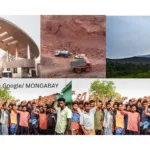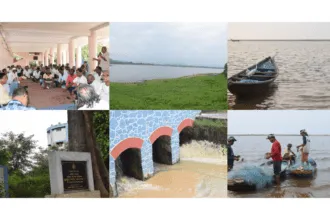Pulanga Annual lecture
By Manshi Asher*
It is an honour to be invited here to this very important initiative called the Pulanga lecture series and am especially proud to be a part of the line up listening to the names of the speakers before me. When Professor Swarnamayee asked me to actually give the title of the talk and also my speech in writing I was feeling under pressure. It was actually simple to give the title – ‘Examining the challenges of climate action’, because everything and anything can be connected with Climate Change these days. But when I had to write the exact content I was a bit confused. I have been a researcher and activist who is associated with environmental justice issues, I have been a co-traveller but not really a speaker or a neta in the people’s movements. And what can I say after all standing in the place which has been my university. There is the university where one acquires formal knowledge and then there is the university where one gets real knowledge. Orissa the land of the indigenous people, their movements and struggles against displacement and exploitation is where I have really learnt about the intent, dynamism and impact of collective and constitutional action – some 15 to 20 years ago when I used to visit here often. So what can I say here today to you all that you all haven’t thought about already? Then I told Swarna ji that I will speak about the Himalaya – simply because if I see my last 25 years 27 years – I have spent nearly 20 in the pahar – first five years in Uttarakhand and then in Himachal.
And even as I was grappling with the exact material, just two or three days before I was to reach here a tragedy struck in the neighbouring region – while this is being called a tragedy for the ‘nation’ which it is because of the innocent tourists who have been killed, because of the massive lapse in security – I think it raises some important questions about our relationship with a region which has been at the centre of a historical conflict – which is Kashmir. But actually this is a region as a whole – which we call the Himalaya – a mountainous borderland.
Our gaze towards the Himalaya fluctuates between two extremes – one is, the Himalaya as a strategic frontier or barrier that separates us from neighbours – an area that we need to control. And on the other hand is the Himalaya of the reels – the one that is aesthetic, a place of beauty to be consumed, which also is in state of crisis due to landslides and floods – And as you can see that this news of the Joshimath like land-slides and land subsidence in Ramban Jammu which has disrupted life has received little attention. But as long as the tourists are safe our attention does not go there.And as you can see that this news of the Joshimath like land-slides and land subsidence in Ramban Jammu which has disrupted life has received little attention. And even during COVID while the mainstream media covered little about what has happened to the people of the mountain states, there was news about how the snow peaks were visible from Punjab.
And in case of the Pahalgam incident if we just look at the response of the government – the first response was to hold in abeyance the Indus Water Treaty, an agreement arrived at in 1960 – it becomes weaponised every time there is trouble in the borders. And because India is an upper riparian country we threaten with stopping the flow of rivers which form the Indus Basin – Himachal, Jammu-Kashmir and Ladakh and then Punjab to Pakistan on which millions of people depend. While whether this is possible and whether this will happen or not is another thing – it’s the exercise of this control over the resources of the region that becomes important and it is not just that India is doing it. The powerful countries like China which is an upper riparian state from where the Bramhaputra for instance flows into India – are also playing the same game of control.
Have you people heard of the Great Game which refers to the diplomacy between the British and Russia back in the 19th century to gain control over the mountains of Central Asia. It seems that with different players the same kind of geopolitics is governing the region as what has been called the new great game. For us ordinary citizens – the question is what about the people and societies who have lived in this area for centuries and how have these developments impacted these societies and the landscape; how do these shape the politics in times when the climate crisis is also a challenge that is being faced.
So in this session let us try to understand the challenges faced within the Himalaya in India are spread today across 12 states from the Eastern to the Western Himalaya with four major altitudinal zones – the Shiwaliks, Mid Himalaya, the Greater Himalaya and there trans-Himalaya. Altitude is important because it is the key distinguishing feature from the plains. Formed over millions of years ago through a collision the place is understood as one which is geologically dynamic and seismically active even as the mountains continue to form. The region is also known as the Third Pole – supporting a population of nearly 5 crore in India and several times more I think auto 60 crores if we look at the sediment that these three river basins, the Indus, the Bramhaputra and Ganges have carried to form the Punjab plains, the indo-gangetic delta and fertile plains of Assam which feed millions of people and are the basis of our food security.
And the diversity of the landscape is also reflected in the people of the region, with varied socio-ecultural practices, ethnicities and livelihoods. While today we tend to highlight the fragility of the region, historically this terrain even though hazard prone lent a great degree of stability – as people had access to different slopes and altitudes to farm diverse crops and the alpine pastures and grazing lands along with forests around which occupations and socio-cultural systems were built provided adaptability, mobility, autonomy. While we see these regions as remote there was a great deal of movement and connectivity which facilitated trade. All this was disrupted in a span of a 100-150 years starting from the early 19th century after the Anglo Gorkha war, as the imperialists made inroads into the mountains. The State here was essentially till then ruled by kingdoms and bunch of princely states who were not as powerful as the kingdoms of the plains. Historians attribute this to the fact that the agricultural surplus was less and therefore the militaries were not as powerful and secondly also because of the geographic inaccessibility of the region.
But to cut the lo ng story short with the colonial takeover of the administration – which includes of course the commodification of land and forests; the settlements that take place; the breakdown of the power of deity based societies; increasing movement from the plains and a greater brahminical influence and also as writer Amish Mulmi from Nepal says, “History has severed the links between many Himalayan communities”.
And we see a continuation of many of these colonial capitalist tendencies in the post- colonial independent era with dam building which drowned thousands of people who gave their lands with a meagre compensation, as happened in the case of the Bhakra dam because they considered it as a sacrifice for the nation. They were displaced in the plains of Haryana and Rajasthan and many returned back to have settled in forest lands for which they still do not have ownership rights and suffer with the label of encroachers. Or let us look at the Scientific forestry which created Chir Pine Monocultures which changed the land use practices as pastures go taken over with trees for the commercial interests. Right up to the 1980s these were planted, and their highly combustible pine needles are cause of forest fire but headlines only call this a climate issue whereas this is the combined result of forest policies which alienated people from the commons for revenue and later in the name of green cover.
Uttarakhand is oft called the land of the Chipko movement and this image which many say has been recreated is popular globally for the tree huggers but what this was in erstwhile Uttar Pradesh was an assertion of ownership over resources and for the Pahari identity which we also see in the struggle for a separate state.
It is ironic that the green felling ban that followed this movement put restrictions on access to timber for the local communities who were questioning illicit felling by companies and the forest corporations. And then how were people to continue architectural practices that required access to good wood for instance the Kath Kuni construction which there is now a lot of advocacy for – that this should be revived because it is earthquake resilient. The fact is that the market has made cement cheaper and lack of access to timber rights means people do not have a choice but to shift to concrete constructions.
In the era of neoliberal capitalism, the hydropower and tourism mega infrastructures have further changed the land use rapidly and led to large scale deforestation and soil erosion. Nearly 72% of the hydropower generation is now planned from the Himalayas of which most of it is under construction or commissioned in the Western Himalayan state and now the focus is shifting to the eastern Himalayan states like Arunachal Pradesh. These projects have changed the landscape and altered the geo-hydrology increasing the risk of landslides and flash floods. The muck dumping from all the construction along the river adds to the silt load and causes destruction downstream – where as in the headlines we call these ‘natural or climate disasters’. And the irony is that these projects are being built in the name of clean energy. In reality these are socio-political and historical disasters.
Like this landslide in a village called Urni when the land use has shifted gradually from an oak forest to an apple orchard, and then roads were built and finally after the tunnel was dug underneath – the landslide was activated and people have lost orchards and are not even entitled to compensation or rehabilitation because there is no ‘scientific evidence’ that the landslide was triggered by the project. And in these areas indigenous youth have been raising consciousness on the impacts of these projects – with the slogan ‘No means No’.
The Western Himalaya is today home to several environmental conflicts and resource contestations. And this is also a time when the Hindukush Himalaya are the largest recipients of climate finance and within these it is India which gets a large part of the aid for climate adaptation. However, these projects with their top down approach and same old practices like plantations or fortress conservation cannot lead to resilience building or adaptation. Plantations have already caused enough alienation and will continue to do the same – we need to address the historical injustice in colonial capitalism which is in arenas of both knowledge and resource regimes.
At the national level when I began my environmental justice work the focus was a lot on democratisation of environmental decision making. This was the late 1990s where on one hand we had economic reforms and on the other several progressive legislations were demanded for – and there was some respite with laws like the Forest Rights Act, the Right to Information Act or the law for Rehabilitation. However, in the last ten fifteen years we have seen a non- implementation, death by gradual dilution and a complete breakdown of the environment regulatory framework. Now the entire environmental and climate agenda is being laid out by the government – and we have big ideas like NET ZERO or GREEN CREDITS or CARBON TRADE which is all about monetizing and privatising carbon and forests.
The recent Supreme Court judgment (M.K. Ranjitsinh) celebrated as a milestone in rights based climate constitutionalism in India further obscures these realities in the judicial arena. The court while upholding the construction of a mega power project at the cost of pastures and forests, habitat of an endangered bird, opined positively in favour of ‘climate mitigation’ based on international obligations on energy transition, side-lining domestic legal frameworks. While climate policy claims to prioritise protection of ecosystems, the judiciary has created a false binary of climate mitigation vs. biodiversity conservation. Earlier it was development vs environment and now it is climate vs biodiversity. This by itself seems ridiculous. Questions of power in the production of knowledge around causal factors, drivers and impacts of climate change, and how this further reinforces the power asymmetries within the community, society and decision-making systems at large, are inescapable.
So, we need to now really think of countering the dominant narratives around climate like we have done with development because the forces controlling these are the same. And climate has been turned into an expert and science led subject where the ordinary people and their lived experiences are not taken into account. We need to deal with the environment and climate as political issues. And while we continue the discourse on alternative economic systems, these experiments are happening in silos. We cannot also just focus on legal interventions and advocacy, as institutions are also crumbling. We therefore need to come out with more creative initiatives that counter the way we think of well-being and how do we imagine future socio-ecological relationships. For this I feel that three principles are critical to guide us. Democratise – for real participation not just representative democracy, decentralise – also we need a very place based, localised and situated approach – instead of copy paste so that voices of diverse people are on board and most importantly decolonise – we cannot continue with this approach that our problems will be solved at the COP which is dominated and co-opted by the fossil fuel lobby. The times are difficult and the wave of authoritarianism is not just in one country but we see it across the globe – so we need to go beyond just policy advocacy – and look for a cultural revolution and a psychosocial transformation in these grim times. And we have no choice but to be hopeful and continue everyday struggles and resistances for a better world. The fact that young people sit here in the audience makes me hopeful. We do not have a choice but to be hopeful.
Few missed words: People’s movements for resistance and renewal have had a transformative impact historically in the world. It is important to collaborate and build bridges across initiatives for cross learning and building solidarities at the intersections of environmental, economic, social, political and economic justice with common and plural visions. We need to let the spirit of collaboration, collective action and mutual aid to guide us.
*(Manshi Asher is a Thinker, Writer and Activist who lives in the Himalayan Region)
(The Pulang Lecture was delivered on April 27, 2025, at Lohia Academy, Bhubaneswar. We thank Prof. Dr Asha Hansh and Prof.Dr Swarnamayee Tripathy of Gabesana Chakra for making Samadrusti their Media Partner. A proper academic version of this lecture will come up later with all relevant notes and references.)
Comments
0 comments







